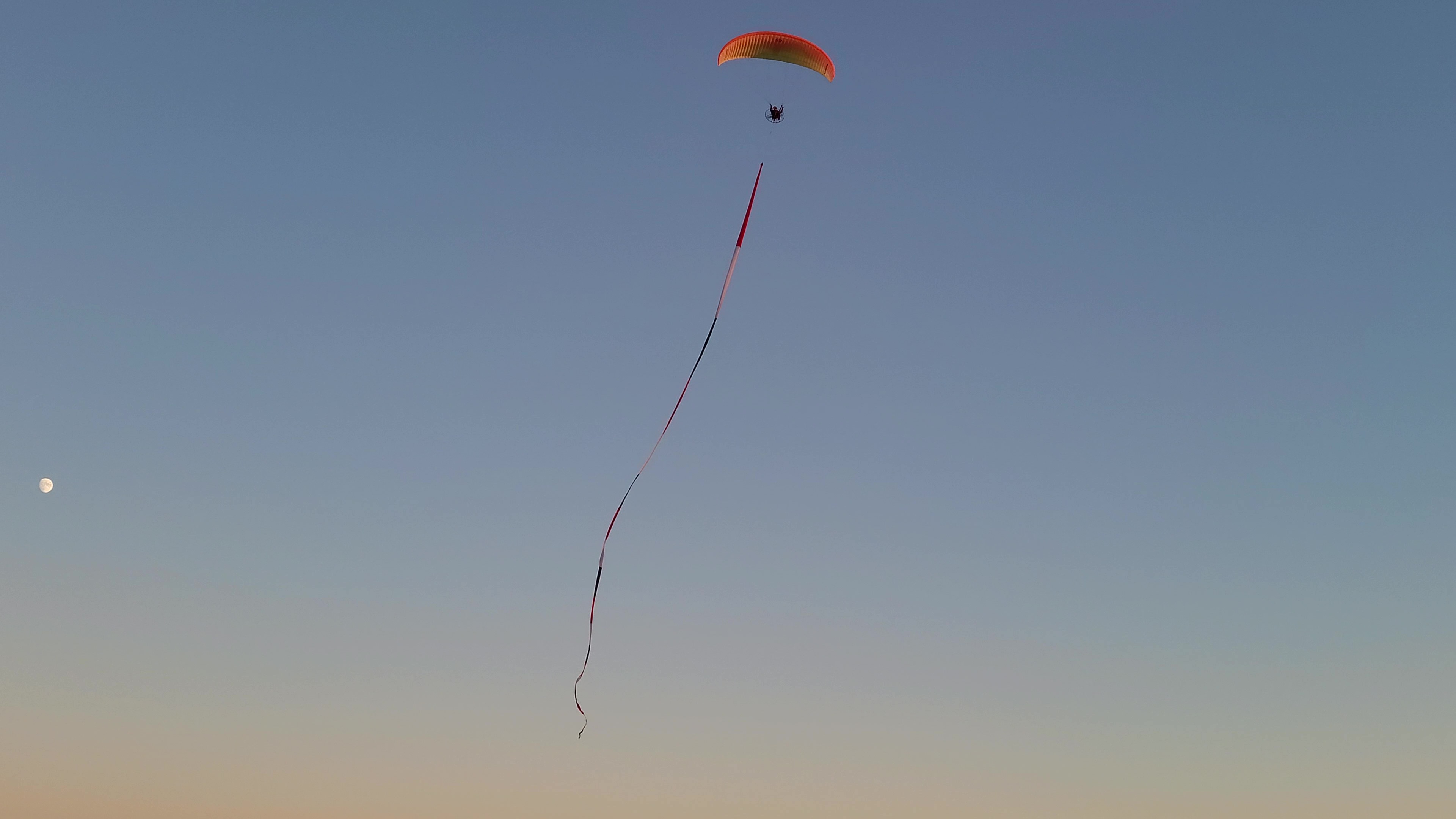Very long streamer preparation & deployment for powered paragliders
by Had Robinson
updated October 17, 2025
Discussion
Video of a 1,000' streamer tow
Video of a PPG launch & deployment of a 1,000' streamer
Our team has developed a safe and practical way for experienced paramotor pilots to deploy and tow these very long streamers. Streamers (up to 1,000') may be towed by a powered paraglider. Length is not so much the limiting factor as the size and weight of the deployment bag (D-bag). As the length of the streamer increases, so does the weight and size of the D-bag. After a point, it becomes more difficult to see ahead while flying because the D-bag must be attached to the front of the paramotor where the D-bag and paramotor turn the pilot into a sandwich.
The longer streamers also have greater drag and this can cause uncomfortable fatigue in the foot and leg that the streamer is attached to. Bigger paramotor engines are required to tow the longest streamers e.g., the Thor 130, the Moster 185, or larger. However, streamers can be towed by a Top 80 but traveling in a straight line results in a gradual sink. This is overcome by gaining altitude doing a spiral where drag is greatly reduced and the going straight again.
Ordinary fixed wing aircraft have a complicated way to pick up a streamer or banner from the ground using poles and hooks. Slow moving paramotors, on the other hand, can launch with the streamer packed in a kitchen trash bag, climb out to altitude, and deploy the streamer safely.
We have also had accidents picking up a streamer bridle with a foot. One missed the pickup device and had a frustrating time trying to pick it up again and wasted precious time allotted to us during an air show. Another pilot came in to pick up a streamer, got a bit too low, caught his foot, and did a nice face plant – tearing up his prop and slicing a few lines on his glider.
After such incidents, we decided there must be a better, safer way that works 100% of the time. For air shows, this is a mandatory requirement. On the other hand, at casual events, who cares if you miss it? At contests, someone drills in and props/lines get whacked – it’s part of the deal. But at public events like what we do, it looks bad. Hooking the bridle (just a foot wide) then climbing out with a 1,000' streamer behind is dicey unless the pilot is at an airport. It can hook on stubble in the grass, a hidden post, or rock. You get the idea....
Launching and climbing with a D-bag is more of a safety issue. A bonus is that you can fly efficiently to some remote site and THEN deploy the streamer.
Paragliders, unlike all other aircraft, move so slowly that streamer drag is not a significant problem up to 750'. Climbing out with a 1,000' streamer, for example, is easier done by circling. This keeps the streamer moving in a tight circle at a few miles per hour – an easy task. Heavier ultralights (wheeled powered paragliders) are not able to safely turn in circles small enough to adequately climb with the streamer attached.
Below, team members Lee Boone (deceased) & Had Robinson perform in the Amigo Airshow, El Paso, TX
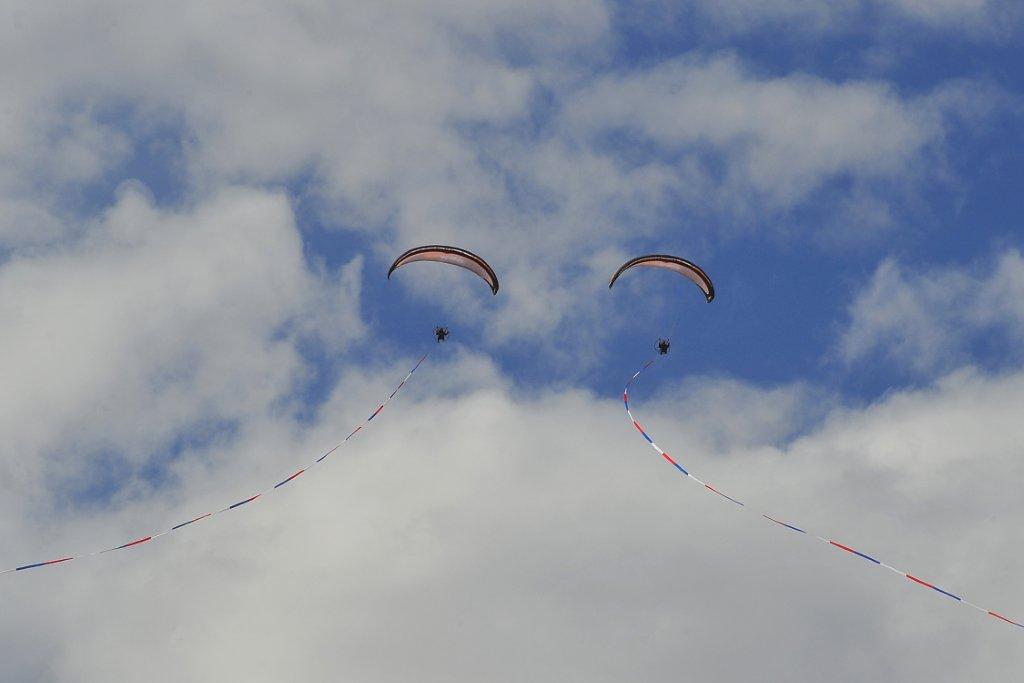
photo by John Shaw
The streamers deployed in the photos here are approximately 700' long x 19" wide and are made of ripstop nylon tent/hammock fabric.
The hardest part we face with streamers is the launch and the complications that happen at that time. The next hardest is to deploy the streamer at the event at the right time and place. You only get one opportunity to get things done correctly.
General practices
Towing a streamer is about comfortably dealing with increased drag from having a very long tail. When towed in a straight line, a streamer is always directly behind and at the same altitude as the pilot. When circling, the streamer's speed through the air is much less and the length near the end will become zero and it will slowly drop towards the ground.
- An assistant should be available for help with attaching the deployment bag to the pilot before launching.
- Only launch in an area where you can easily abort during the first 30 seconds of flight.
- The paramotor propeller *must* not extend beyond the rim of the cage. If it does, it will snag the towline.
- Wear running shoes because it is easier to remove the bridle than from boots.
- Winds should be light or nil with no thermic activity. Having the streamer going up in a thermal behind you somewhere will complicate things and create a hazard.
- Before launching, chose a suitable location on the ground where you can drop the streamer after the tow. It must be short grass. Asphalt will allow the streamer to roll up in a wad if there is any wind. Tall grass doubles the time required to repack the streamer
- Until the streamer is deployed, you *must* be able to shut down the engine at any time. This means check the engine kill switch before launching. Getting part of the streamer wound around the prop could prove to be fatal to the pilot. Think about this....
- Always trim your glider to go as slow as possible because the drag increases dramatically as your speed increases.
- Do not deploy or tow the streamer at low altitudes (below 100') unless you are certain that it will not contact water or anything which could snag it. When a long streamer gets caught by something on the ground, it can take hours to recover it, especially if it hangs in trees or on power lines.
- You *must* be 100% comfortable flying with one hand.
- Pilots *must* be extremely careful around other aircraft because of decayed situational awareness.
- Do *NOT* deploy except when at altitude, the paramotor is at idle, and there are no other aircraft around. This will prevent the streamer from being sucked into the propeller, colliding with another aircraft, or dropping the streamer on another pilot. Until you have done 20 streamer flights, deploy the streamer when the AGL is equivalent to the length of the streamer plus about 500'. For example, if the streamer is 700' long, the pilot should fly to at least 1,200' AGL before deploying the streamer. Once you understand how a streamer works when towed and have had many flights, THEN a streamer may be deployed at a few hundred feet. Low altitude deployments greatly add to the show.
- Practice deployment on the ground before doing it in the air.
- If you fly with a flight deck, you may not be able to use it when launching with very long streamers because the deck will push the D-bag even higher, cutting off frontal visibility.
- If you over-seal the D-bag with masking tape, it requires more time to open the bag when you are ready to deploy. On the other hand, a carelessly or incorrectly sealed D-bag can suddenly "leak" the streamer which will – without exception – find its way back into the propeller. A streamer that becomes entangled in the lines of another glider (including your own) could cause unpredictable handling. We learned all of this the hard way....
- When towing the streamer, always have an "out" where you can fly away into clear air space.
- Do not tow with another pilot unless you have practiced flying in formation together without streamers. Piloting your paramotor must be second-nature as you will be occupied with the streamer and have little concentration left to think about flying, especially directional control.
- Landing in a straight line with the streamer attached to the foot is possible but not preferred for a skilled pilot because it doubles the time required to repack it. Dragging it through tall grass, for example, greatly stresses the streamer fabric and wears it out quickly. PPG4 pilots can circle tightly over an operating area (preferably at an airport) and have a much easier time repacking the streamer in the D-bag.
- Practicing before the public or friends is not the best venue to learn this skill. Towing a streamer requires *intense* concentration. Task saturation is about 100% most of the time so everything but the streamer must be 2nd nature.
How to deploy a streamer
A. Preparing the streamer
You will need:
- FLY WITH A HOOK KNIFE! I have had to cut away the towline after it got tangled in the cage. It also got tangled in the free-spinning propeller and I had to land without power. At the same time, the streamer became loose and fell to the earth. What can go wrong did go wrong – everything went wrong. Thankfully, nobody was killed or hurt. Equipment damage was minimal.
- Kitchen sized trash bag e.g., Sam's Members Mark Power Flex – these bags are stretchy, tough, and light weight. They also have a loop of pastic tape to tie the bag closed. The bag *must" be fully closed.
- A waste basket the size of the trash bag. Note: photo below shows a waste basket. We have found that a full sized kitchen trash container is much better. You cannot tightly pack the streamer without it. Count on spending 20 minutes packing a 1,000' streamer if it is dropped in a tight circled (less than 40 yards in diameter).
- 15' of 50 lb. test cheap towline. Get the slipperiest line possible as it tends to get knotted when deployed. If the line gets in the propeller, it is better to have this kind of line rather than glider line. Note: connect the towline to the bridle and the steamer with a bowline knot. Seal the knots with nail polish. We have had surprises caused by knots loosening during deployment.
- 1" masking tape to seal the D-bag.
- Bridle – it can be a speed stirrup but it is easier (and safer) to use a homemade arrangement using a piece of fabric and a round stick.
- A 36" bungee cords to attach the D-bag to the pilot – they must tightly hold the D-bag to the front of the pilot. The cords can be shortened by putting a knot where the cord goes through the hook. Longer streamers may require (2) bungee cords. The bungee can be stowed after deployment or dropped from the air at a convenient spot, usually near take-off. Tie some orange flagging tape to the center of the bungee which can help recovery as it drops.
B. Packing the D-bag
Put the kitchen trash bag in the waste basket and start stuffing the streamer – end first. The technique here is similar to how climbers stuff a rope into a rope bag. You must not attempt to fold, wrap, roll, etc. the streamer in any way. It is slippery nylon and will deploy smoothly. Leave the lines outside the bag for now.
Remove the D-bag from the container and lay the line on the top of the packed streamer. Pack the towline with the streamer. Note: the photos show a piece of glider lined being used as the towline. This is *not* recommended. The bag shown below is not recommended because it does not have tie to close the opening. We no longer use glider line for anything because it does not break easily and it forms friction knots much easier than slippery poly-type lines. Attach the tow bridle to the outside of the bag with masking tape. If you put it in with the lines, it tends to get tangled up with the lines. Remember: ANYTHING LOOSE WINDS UP IN THE PROP!
C. Attach the D-bag
Use the bungee cord(s) to attach the D-bag as shown in the photo below. The bungee cord(s) can be hooked to the cage or the paramotor frame. If the cords are too tight, the pilot may have difficulty unhooking them. If they are too loose, the D-bag falls out when launching. Place the bungee over the lower center of the D-bag. If it is high on the D-bag, the D-bag tends to slip out. Bigger streamers may require a second bungee cord near the top of the D-bag.
The pilot is ready to go. I recommend that pilots attach themselves to the glider, do their pre-flight check, and THEN attach the D-bag. The streamer below is a short (700') streamer. The presence of the D-bag may hinder a clear view of the pilot's critical flying areas such as the speed system and riser attachments and also complicates the pre-flight. The photo below (the late Lee Boone) seems to suggest that the D-bag does not obstruct the pilot's view. However, that all changes when he sits down in the harness.
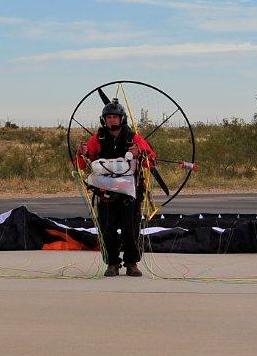
photo courtesy of John Shaw
D. Streamer deployment and recovery
NEVER FLY OVER ANYONE OR ANYTHING THAT COULD BE HARMED BY A DROPPED D-BAG FILLED WITH A STREAMER!
It does not matter if you have permission or not to fly over a congested area. An undeployed streamer in a D-bag falling out of the air could seriously hurt or kill! The D-bag could get loose at any time!
1. Trim your glider for slowest possible speed.
2. If you decide to jettison the bungee cord, climb to a hundred feet or so, go to one-handed flying or let go of the toggles, and remove the bungee cord(s). Using one hand, fly back to launch and drop the bungee cord(s) AFTER GOING TO IDLE. An assistant can get them for use next time. There is minimal danger of losing the streamer because the wind keeps it tightly pressed against the pilot. However, flying in turbulent air GREATLY increases the risk of dropping the streamer.
3. Climb out to a safe altitude. It is difficult to find a visible place for your variometer or GPS with the D-bag just in front so you may have to guess when you are high enough to deploy.
4. Fly straight. Ensure that you will not collide with anything for a minute. Pick an area on the ground 10 or 20 yards up wind from an open area so that if the streamer goes all the way to the ground, it will not snag on anything. When the streamer is deployed, it goes straight down while you continue going straight ahead. This is a beautiful and unique event for those watching from the ground!
5. Go to idle. If you are not at idle, the streamer will be sucked in to the propeller. Please do not ask how we know this will happen....
6. Fly one-handed or let go of the toggles but not the throttle.
7. Undo the tie strap that has closed up the D-bag. Break/tear the piece of masking tape that holds the bridle to the top of the D-bag. It is not hazardous to continue flying with the D-bag open but you *MUST* keep a hand on the packed streamer. If a tiny piece of it escapes, it will instantly go into the prop.
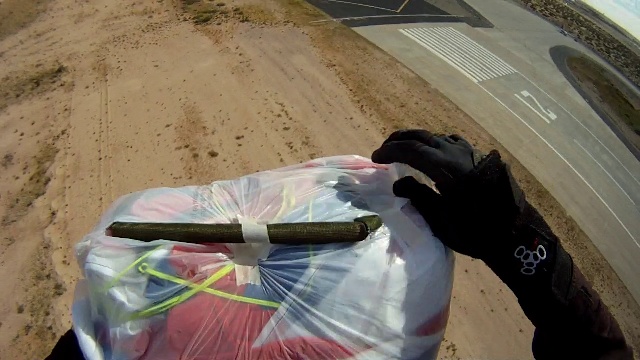
8. Grasp the tow bridle with one hand, lean over as much as possible, and then push the D-bag down and OVER (not between) your legs. You will feel a jerk on the bridle. Put the bridle on your foot as soon as possible. DO NOT POWER UP THE ENGINE UNTIL YOU ARE CERTAIN THAT THE STREAMER IS DEPLOYED CORRECTLY.
If the bag does not open immediately, you may have to yank up smartly on the bridle to get it free, just as you might do with a reserve parachute. If the bridle line gets tangled in the streamer, LET GO OF EVERYTHING IMMEDIATELY! Go and land and recover the streamer. The drag of a tangle streamer is similar to throwing your reserve parachute. Please do not ask how we know this.... Generally, do not fiddle around in the air because you will not be concentrating on flying, on hitting other pilots, on hitting trees or powerlines, or getting too low. It will not hurt the streamer to drop it from any altitude. If it is still in the D-bag, it will burst and the streamer will rapidly expand into a big pile.
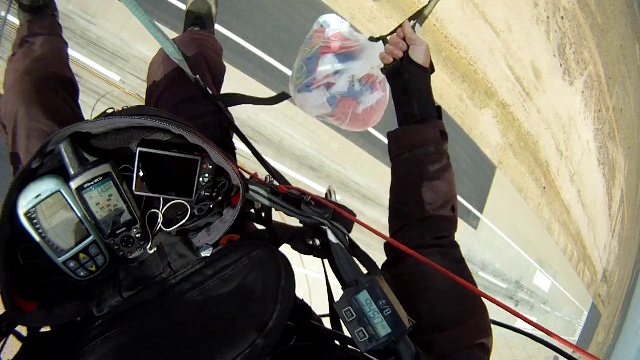
Below, the D-bag dropping to earth with 700' of streamer pouring out is also a beautiful and unique sight. It is a one of kind thing that only we can do.
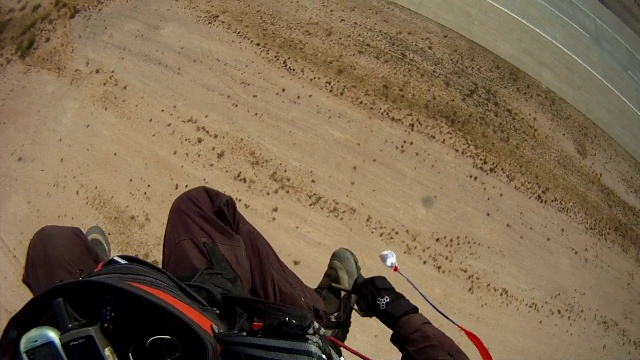
9. *Immediately* put the bridle on your foot (see the photo just above). At this time, the drag from the streamer will be less and it will be easier to put the bridle on your foot. Every second counts.
Why not attach it with a karabiner to the engine frame or harness? With the bridle on your foot, you are always aware of the streamer's drag and can sense any change quickly. You can also discover how to ascend with the streamer while minimizing drag and so increase your climb out rate. If you snag something on the ground, you will have plenty of time to drop your bridle and not tear the streamer and/or break your weak-link.
10. Re-grasp the toggles, apply power so that you do not lose altitude. Keep your eye on the streamer. It will begin to trail out behind you. If flying in a straight line, the end of the streamer will only drop about 50'. At this time you can begin your show with things like making a huge coil, flying through a loop in the streamer (it will not form a knot, lowering the streamer to a single spot on the ground or in a pond or lake then raising it up again. When making tight circles the streamer will sink quickly. With care, the pilot can touch the ground with the end of the streamer and then bring it up again.
Here is a YouTube video of various deployments. Watch the streamer as it deploys – dropping hundreds of feet towards the ground. My desire is that no one gets hurt flying streamers and that we share this beautiful sight with the public.
Towing a streamer at a fair. Remember: ultralights cannot fly over any congested area so keep away a safe distance.
E. After the tow
When you are ready to drop the streamer, fly one-handed and use the free hand to remove the bridle from your foot and tow the streamer using your hand.
Pick a suitable location to drop the streamer. The best place is a large field. Any place else complicates recovery of the streamer e.g., if you drop it on the tarmac of an airport, the streamer can roll and knot up from the slightest breeze, get soiled with oil, run over by other aircraft, etc.
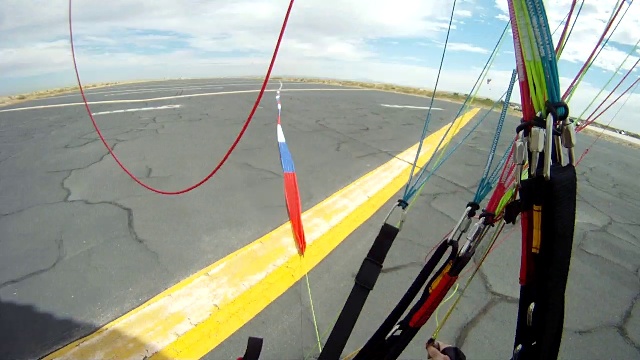
It is easiest to drop it straight on a grassy area but it takes much longer to collect it than if it is in a coil, as in the photo below.
To create a coiled-up streamer on the ground, begin making tight circles at altitude while slowly climbing so you do not fly through your own wake. It will take some minutes for the entire streamer to form a uniform coil in the air. Once this is done, go to idle and let it drop to the ground. At 100', let go of the streamer.
If you drop the streamer too high it can drift with the wind and land in such fun places as in power lines or trees. If this happens, you may have to abandon your streamer.
Practice makes perfect with this, especially if there is any surface wind. It takes about (15) seconds for a streamer to drop 100' so if the surface wind is (5) mph, for example, the streamer will drift about 175' before coming down to the ground. Therefore, you will want to fly upwind for this distance.
Repack the streamer after you land using a new trash bag and the waste basket.
Be smart, be safe. – Had
![]()



